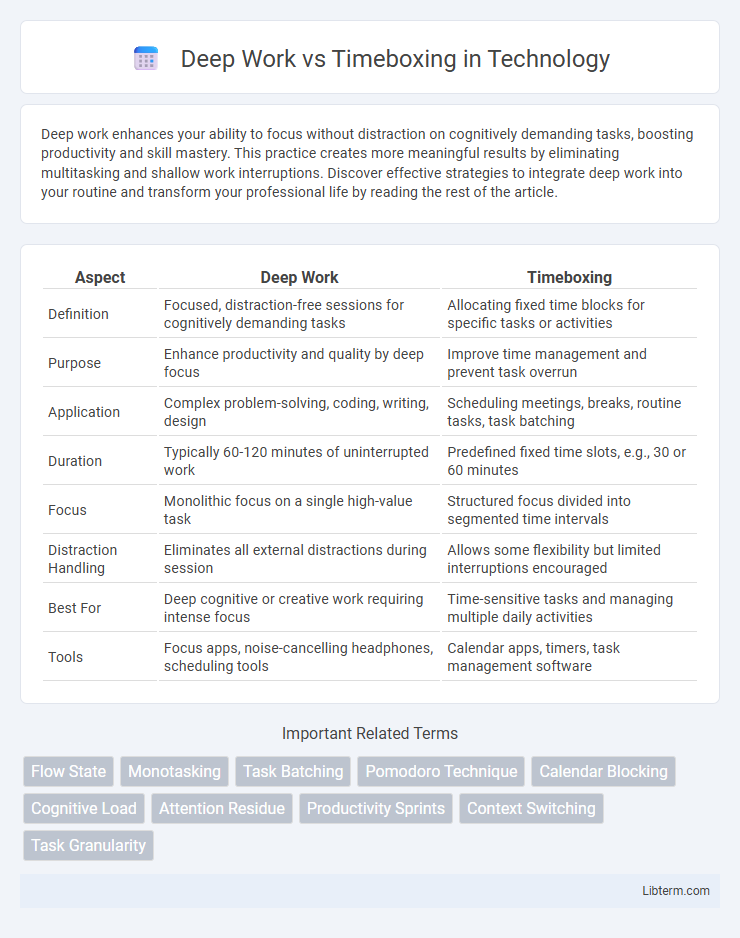Deep work enhances your ability to focus without distraction on cognitively demanding tasks, boosting productivity and skill mastery. This practice creates more meaningful results by eliminating multitasking and shallow work interruptions. Discover effective strategies to integrate deep work into your routine and transform your professional life by reading the rest of the article.
Table of Comparison
| Aspect | Deep Work | Timeboxing |
|---|---|---|
| Definition | Focused, distraction-free sessions for cognitively demanding tasks | Allocating fixed time blocks for specific tasks or activities |
| Purpose | Enhance productivity and quality by deep focus | Improve time management and prevent task overrun |
| Application | Complex problem-solving, coding, writing, design | Scheduling meetings, breaks, routine tasks, task batching |
| Duration | Typically 60-120 minutes of uninterrupted work | Predefined fixed time slots, e.g., 30 or 60 minutes |
| Focus | Monolithic focus on a single high-value task | Structured focus divided into segmented time intervals |
| Distraction Handling | Eliminates all external distractions during session | Allows some flexibility but limited interruptions encouraged |
| Best For | Deep cognitive or creative work requiring intense focus | Time-sensitive tasks and managing multiple daily activities |
| Tools | Focus apps, noise-cancelling headphones, scheduling tools | Calendar apps, timers, task management software |
Understanding Deep Work: A Brief Overview
Deep Work, a concept popularized by Cal Newport, emphasizes focused, distraction-free productivity to achieve high cognitive performance. It requires cultivating sustained attention during work intervals to maximize creative output and problem-solving efficiency. Unlike Timeboxing, which allocates fixed time slots for tasks, Deep Work centers on the quality of uninterrupted concentration rather than just scheduling.
What is Timeboxing? Core Principles Explained
Timeboxing is a time management technique where specific blocks of time are allocated to tasks, ensuring focused work periods and minimizing distractions. Core principles include defining fixed time slots, committing to completing tasks within those slots, and preventing task overrun to maintain productivity. This method enhances efficiency by creating structured limits that encourage concentration and timely task completion.
Key Differences Between Deep Work and Timeboxing
Deep Work emphasizes uninterrupted, focused sessions dedicated to cognitively demanding tasks, enhancing productivity and skill mastery. Timeboxing allocates fixed time slots to activities, promoting time management and preventing overcommitment by limiting work duration. The key difference lies in Deep Work prioritizing quality and depth of focus, while Timeboxing centers on structured time allocation for tasks.
Benefits of Deep Work for Focus and Productivity
Deep Work enhances focus by eliminating distractions, enabling prolonged periods of intense concentration that significantly improve productivity. This method fosters deep cognitive engagement, which leads to higher quality output and faster skill acquisition. Unlike Timeboxing, Deep Work prioritizes depth over strict time limits, resulting in more meaningful and impactful work sessions.
Advantages of Timeboxing for Task Management
Timeboxing enhances task management by setting fixed time periods for completing specific activities, which boosts focus and reduces procrastination. This method improves productivity through structured scheduling, allowing clearer prioritization and better control over work duration. It also helps balance workload by preventing tasks from dragging on, thereby increasing efficiency and meeting deadlines more consistently.
How to Implement Deep Work in Your Daily Routine
Implement deep work by dedicating specific blocks of uninterrupted time to focus on cognitively demanding tasks, minimizing distractions such as notifications and social media. Timeboxing enhances this approach by scheduling these deep work sessions within fixed time intervals, optimizing productivity through structured, goal-oriented periods. Using tools like calendars or apps to allocate and protect these deep work slots ensures consistent practice and measurable progress in your daily routine.
Step-by-Step Guide to Effective Timeboxing
Timeboxing enhances deep work by allocating fixed time blocks dedicated solely to high-focus tasks, minimizing distractions and boosting productivity. Begin by identifying key tasks, then assign specific time slots on your calendar to create firm boundaries that prevent task overrun. Regular reviews of timebox effectiveness and adjustments refine focus, ensuring sustained engagement and optimal output during deep work sessions.
Deep Work vs Timeboxing: Which Suits Your Workflow?
Deep Work emphasizes uninterrupted, focused sessions to maximize cognitive performance, ideal for tasks requiring deep concentration and creativity. Timeboxing allocates fixed time slots to specific activities, enhancing time management and preventing task overrun. Choosing between Deep Work and Timeboxing depends on your workflow's need for sustained focus versus structured task scheduling to optimize productivity.
Common Challenges and Solutions for Both Methods
Deep Work and Timeboxing both face challenges such as maintaining consistent focus and avoiding task overload. To overcome these issues, techniques like setting clear boundaries, prioritizing tasks based on urgency and importance, and using digital tools for tracking progress can be effective. Implementing regular breaks and reviewing performance metrics helps sustain productivity and adapt schedules to real-time demands.
Combining Deep Work and Timeboxing for Optimal Results
Combining deep work and timeboxing enhances productivity by structuring intense focus sessions within fixed time blocks, minimizing distractions and decision fatigue. Timeboxing allocates specific periods for deep work tasks, ensuring dedicated effort while preventing burnout through scheduled breaks. This fusion maximizes cognitive resources, resulting in higher quality output and efficient time management.
Deep Work Infographic

 libterm.com
libterm.com